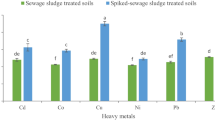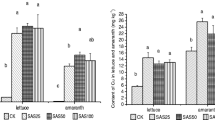Abstract
Purpose
Our main aim objective was to evaluate the transfer of Cd, Cr, Cu, Ni, Pb and Zn to barley (Hordeum vulgare) grown in various soils previously amended with two sewage sludges containing different concentrations of heavy metals. This allowed us to examine the transfer of heavv metals to barley roots and shoots and the occurrence of restriction mechanisms as function of soil type and for different heavy metal concentration scenarios.
Material and methods
A greenhouse experiment was performed to evaluate the transfer of heavy metals to barley grown in 36 agricultural soils from different parts of Spain previously amended with a single dose (equivalent to 50 t dry weight ha−1) of two sewage sludges with contrasting levels of heavy metals (common and spiked sludge: CS and SS).
Results and discussion
In soils amended with CS, heavy metals were transferred to roots in the order (mean values of the bio-concentration ratio in roots, BCFRoots, in brackets): Cu (2.4) ~ Ni (2.3) > Cd (2.1) > Zn (1.8) > Cr (0.7) ~ Pb (0.6); similar values were found for the soils amended with SS. The mean values of the soil-to-shoot ratio were: Cd (0.44) ~ Zn (0.39) ~ Cu (0.39) > Cr (0.20) > Ni (0.09) > Pb (0.01) for CS-amended soils; Zn (0.24) > Cu (0.15) ~ Cd (0.14) > Ni (0.05) ~ Cr (0.03) > Pb (0.006) for SS-amended soils. Heavy metals were transferred from roots to shoots in the following order (mean values of the ratio concentration of heavy metals in shoots to roots in brackets): Cr (0.33) > Zn (0.24) ~ Cd (0.22) > Cu (0.19) > Ni (0.04) > Pb (0.02) for CS-amended soils; Zn (0.14) > Cd (0.09) ~ Cu (0.08) > Cr (0.05) > Ni (0.02) ~ Pb (0.010) for SS-amended soils.
Conclusions
Soils weakly restricted the mobility of heavy metals to roots, plant physiology restricted the transfer of heavy metals from roots to shoots, observing further restriction at high heavy metal loadings, and the transfer of Cd, Cu and Zn from soils to shoots was greater than for Cr, Ni and Pb. Stepwise multiple linear regressions revealed that soils with high sand content allowed greater soil-plant transfer of Cr, Cu, Pb and Zn. For Cd and Ni, soils with low pH and soil organic C, respectively, posed the highest risk.

Similar content being viewed by others
References
Adriano DC (2001) Trace elements in terrestrial environments: biochemistry, bioavailability, and risk of metals, 2nd edn. Springer, New York
Ajwa HA, Tabatabai MA (1994) Decomposition of different organic materials in soils. Biol Fertil Soils 18:175–182
Albaladejo J, Ortiz R, Garcia-Franco N, Navarro AR, Almagro M, Pintado JG, Martínez-Mena M (2013) Land use and climate change impacts on soil organic carbon stocks in semi-arid Spain. J Soils Sediments 13:265–277
Ali H, Khan E, Sajad MA (2013) Phytoremediation of heavy metals—concepts and applications. Chemosphere 91:869–881
Alloway BJ, Jackson AP (1991) The behaviour of heavy metals in sewage sludge-amended soils. Sci Total Environ 100:151–176
Antoniadis V, Tsadilas CD, Samaras V (2010) Trace element availability in a sewage sludge-amended cotton grown Mediterranean soil. Chemosphere 80:1308–1313
Ashworth DJ, Alloway BJ (2008) Influence of dissolved organic matter on the solubility of heavy metals in sewage-sludge-amended soils. Commun Soil Sci Plant Anal 39:538–550
Barceló J, Poschenrieder C (1990) Plant water relations as affected by heavy metal stress: a review. J Plant Nutr 13:1–37
Basta NT, Ryan JA, Chaney RL (2005) Trace element chemistry in residual-treated soil: key concepts and metal bioavailability. J Environ Qual 34:49–63
Bernal MP, Sánchez-Monedero MA, Paredes C, Roig A (1998) Carbon mineralization from organic wastes at different composting stages during their incubation with soil. Agric Ecosyst Environ 69:175–189
Bose S, Bhattacharyya AK (2008) Heavy metal accumulation in wheat plant grown in soil amended with industrial sludge. Chemosphere 70:1264–1272
Branzini A, González RS, Zubillaga M (2012) Absorption and translocation of copper, zinc and chromium by Sesbania virgata. J Environ Manage 102:50–54
Bremner JM, Mulvaney CS (1982) Nitrogen total. In: Page AL, Miller RH, Keeney DR (eds) Methods of soil analysis, part 2. Chemical and microbiological properties. ASA and SSSA, Madison, pp 595–624
Chaignon V, Sanchez-Neira I, Herrmann P, Jaillard B, Hinsinger P (2003) Copper bioavailability and extractability as related to chemical properties of contaminated soils from a vine-growing area. Environ Pollut 123:229–238
Chaney RL (1990) Public health and sludge utilization. Biocycle 31:68–73
Doncheva S, Poschenrieder C, Stoyanova Z, Georgieva K, Velichkova M, Barceló J (2009) Silicon amelioration of manganese toxicity in Mn-sensitive and Mn-tolerant maize varieties. Environ Exp Bot 65:189–197
EEC/86/278 European Community Council Directive 86/278/EEC of 12 June 1986 on the protection of the environment, and in particular of the soil, when sewage sludge is used in agriculture
Foster JC (1995) Soil physical analysis. In: Nannipieri KA (ed) Methods in applied soil microbiology and biochemistry. Academic Press, London, pp 105–115
Gee GW, Bauder JW (1986) Particle-Size Analysis. In: Klute A (ed) Methods of soil analysis 1: physical and mineralogical methods, 2nd edn. ASA and SSSA, Madison, pp 383–411
Hamon RE, Holm PE, Lorenz SE, McGrath SP, Christensen TH (1999) Metal uptake by plants from sludge-amended soils: caution is required in the plateau interpretation. Plant Soil 216:53–64
Hooda PS, McNulty D, Alloway BJ, Aitken MN (1997) Plant availability of heavy metal in soils previously amended with heavy applications of sewage sludge. J Sci Food Agric 73:446–454
Houba VJG, Van Der Lee JJ, Novozamsky I, Walinga I (1989) Soil and plant analysis, a series of syllabi. Part 5, soil analysis procedures. Wageningen Agricultural University, Wageningen, The Netherlands
Hulseman J (1966) An inventory of marine carbonate materials. J Sediment Petrol ASCE 36:622–625
Kabata-Pendias A (2004) Soil-plant transfer of trace elements—an environmental issue. Geoderma 122:143–149
Kabata-Pendias A, Pendias H (2001) Trace elements in soils and plants. CRC Press, Boca Raton
Kalis EJJ, Temminghoff EJM, Town RM, Unsworth ER, Van Riemsdijk WH (2008) Relationship between metal speciation in soil solution and metal adsorption at the root surface of ryegrass. J Environ Qual 37:2221–2231
Kandpal G, Ram B, Srivastava PC, Singh SK (2004) Effect of metal spiking on different chemical pools and chemically extractable fractions of heavy metals in sewage sludge. J Hazard Mater 106:133–137
Li Q, Guo XY, Xu XH, Zuo YB, Wei DP, Ma YB (2012) Phytoavailability of copper, zinc and cadmium in sewage sludge-amended calcareous soils. Pedosphere 22:254–262
Marchiol L, Assolari S, Sacco P, Zerbi G (2004) Phytoextraction of heavy metals by canola (Brassica napus) and radish (Raphanus sativus) grown on multicontaminated soil. Environ Pollut 132:21–27
McBride M, Sauvé S, Hendershot W (1997) Solubility control of Cu, Zn, Cd and Pb in contaminated soils. Eur J Soil Sci 48:337–346
McBride MB (2003) Toxic metals in sewage sludge-amended soils: has promotion of beneficial use discounted the risks? Adv Environ Res 8:5–19
McBride MB, Nibarger EA, Richards BK, Steenhuis T (2003) Trace metal accumulation by red clover grown on sewage sludge-amended soils and correlation to Mehlich 3 and calcium chloride-extractable metals. Soil Sci 168:29–38
McBride MB (1994) Environmental chemistry of soils. Oxford University Press, New York
McLaren RG, Clucas LM, Taylor MD, Hendry T (2004) Leaching of macronutrients and metals from undisturbed soils treated with metal-spiked sewage sludge. 2. Leaching of metals. Aust J Soil Res 42:459–471
McLaughlin MJ, Whatmuff M, Warne M, Heemsbergen D, Barry G, Bell M, Nash D, Pritchard D (2006) A field investigation of solubility and food chain accumulation of biosolid-cadmium across diverse soil types. Environ Chem 3:428–432
McLaughlin MJ, Zarcinas BA, Stevens DP, Cook N (2000) Soil testing for heavy metals. Commun Soil Sci Plant Anal 31:1661–1700
McLaughlin MJ, Parker DR, Clarke JM (1999) Metals and micronutrients—food safety issues. Field Crops Res 60:143–163
McLaughlin MJ, Tiller KG, Naidu R, Stevens DP (1996) Review: the behaviour and environmental impact of contaminants in fertilizers. Aust J Soil Res 34:1–54
Moral R, Navarro Pedreño J, Gómez I, Mataix J (1996) Quantitative analysis of organic wastes: effects of sample preparation in the determination of metals. Commun Soil Sci Plant Anal 27:753–761
Natal-Da-Luz T, Tidona S, Jesus B, Morais PV, Sousa JP (2009) The use of sewage sludge as soil amendment. The need for an ecotoxicological evaluation. J Soils Sediments 9:246–260
Navarro-Pedreño J, Gómez I, Moral R, Palacios G, Mataix J (1997) Heavy metals uptake and plant nutrition and development. Recent Res Dev Phytochem 1:173–179
Nelson DW, Sommers LE (1982) Total carbon, organic carbon, and organic matter. In: Page AL (ed) Methods of soil analysis, part 2 chemical and biological methods. ASA and SSSA, Madison, pp 539–579
O’Connor GA, Elliott HA, Basta NT, Bastian RK, Pierzynski GM, Sims RC, Smith JE Jr (2005) Sustainable land application: an overview. J Environ Qual 34:7–17
Pascual I, Antolín MC, García C, Polo A, Sánchez-Díaz M (2004) Plant availability of heavy metals in a soil amended with a high dose of sewage sludge under drought conditions. Biol Fertil Soils 40:291–299
Peralta-Videa JR, Lopez ML, Narayan M, Saupe G, Gardea-Torresdey J (2009) The biochemistry of environmental heavy metal uptake by plants: implications for the food chain. Int J Biochem Cell Biol 41:1665–1677
Qian J, Wang Z, Shan X, Tu Q, Wen B, Chen B (1996) Evaluation of plant availability of soil trace metals by chemical fractionation and multiple regression analysis. Environ Pollut 91:309–315
Santibáñez C, Verdugo C, Ginocchio R (2008) Phytostabilization of copper mine tailings with biosolids: implications for metal uptake and productivity of Lolium perenne. Sci Total Environ 395:1–10
Sauerbeck DR (1991) Plant, element and soil properties governing uptake and availability of heavy metals derived from sewage sludge. Water Air Soil Pollut 57–58:227–237
Scott-Fordsmand JJ (1997) Toxicity of nickel to soil organisms in Denmark. Rev Environ Contam Toxicol 148:1–34
Shanker AK, Cervantes C, Loza-Tavera H, Avudainayagam S (2005) Chromium toxicity in plants. Environ Int 31:739–753
Soriano-Disla JM, Gómez I, Navarro-Pedreño J (2012) The influence of soil properties on the water pollution (nitrate, phosphate and COD) following a single application of sewage sludge to 70 contrasting agricultural soils. Water Air Soil Pollut 223:1783–1790
Soriano-Disla JM, Gómez I, Navarro-Pedreño J (2011) The influence of soil properties on the mobility of metals following a single application of polluted sewage sludge to seventy agricultural topsoils: a laboratory column study. Soil Sediment Contam 20:961–976
Soriano-Disla JM, Gómez I, Navarro-Pedreño J, Lag-Brotons A (2010) Evaluation of single chemical extractants for the prediction of heavy metal uptake by barley in soils amended with polluted sewage sludge. Plant Soil 327:303–314
Speir TW, van Schaik AP, Hunter LC, Ryburn JL, Percival HJ (2007) Attempts to derive EC50 values for heavy metals from land-applied Cu-, Ni-, and Zn-spiked sewage sludge. Soil Biol Biochem 39:539–549
Acknowledgments
Jose M. Soriano-Disla gratefully acknowledges the Government of Valencia for a Post-Doctoral research fellowship (APOSTD/2011/034).
Author information
Authors and Affiliations
Corresponding author
Additional information
Responsible editor: Jaume Bech
Rights and permissions
About this article
Cite this article
Soriano-Disla, J.M., Gómez, I., Navarro-Pedreño, J. et al. The transfer of heavy metals to barley plants from soils amended with sewage sludge with different heavy metal burdens. J Soils Sediments 14, 687–696 (2014). https://doi.org/10.1007/s11368-013-0773-4
Received:
Accepted:
Published:
Issue Date:
DOI: https://doi.org/10.1007/s11368-013-0773-4




